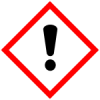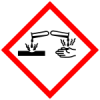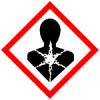Toxicty
GHS safety labels
- H302

Harmful if swallowed
Class: Acute Toxicity
Subclass: Oral - H312

Harmful in contact with skin
Class: Acute Toxicity
Subclass: Dermal - H318

Causes serious eye damage
Class: (Corrosion)Damage/irritation
Subclass: Eye - H332

Harmful if inhaled
Class: Acute Toxicity
Subclass: Inhalation - H335

May cause respiratory irritation
Class: STOT-respiratory irritation
Subclass: Single exposure - H351

Suspected of causing cancer (state route of exposure if it is conclusively proven that no other routes of exposure cause the hazard)
Class: Carcinogenicity - H373

May cause damage to organs (state all organs affected, if known) through prolonged or repeated exposure (state route of exposure if it is conclusively proven that no other routes of exposure cause the hazard)
Class: STOT
Subclass: Repeated exposure
